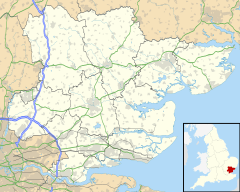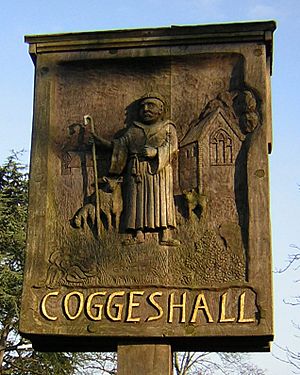Coggeshall facts for kids
Quick facts for kids Coggeshall |
|
|---|---|
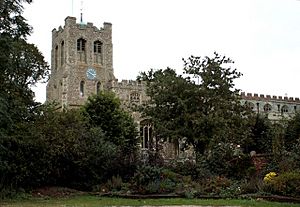 St. Peter-ad-Vincula church, Coggeshall |
|
| Population | 3,919 (2001) 4,727 (2011) |
| OS grid reference | TL853226 |
| Civil parish |
|
| District |
|
| Shire county | |
| Region | |
| Country | England |
| Sovereign state | United Kingdom |
| Post town | COLCHESTER |
| Postcode district | CO6 |
| Dialling code | 01376 |
| Police | Essex |
| Fire | Essex |
| Ambulance | East of England |
| EU Parliament | East of England |
| UK Parliament |
|
Coggeshall (pronounced like "Cox-all" or "Cog-ish-all") is a town and civil parish in the Braintree area of Essex, England. It sits between the towns of Braintree and Colchester, right on an old Roman road called Stane Street and by the River Blackwater. In 2011, about 4,727 people lived there. Coggeshall is special because it has almost 300 buildings that are officially "listed," meaning they are important historical sites. It also has a market that was first allowed by King Henry III way back in 1256.
Contents
- What's in a Name? The Meaning of Coggeshall
- A Look Back: The History of Coggeshall
- Where is Coggeshall? Geography
- How Many People Live Here? Demography
- Famous Places: Landmarks in Coggeshall
- Getting Around: Transport
- Fun Facts and Culture
- Famous People from Coggeshall
- Learning in Coggeshall: Education
What's in a Name? The Meaning of Coggeshall
The name Coggeshall has a long and interesting history, with many ideas about where it came from. It was spelled differently over time, like Kockeshale around the year 1060. Some people think the first part of the name comes from an old English person's name, like Cocc or Cogg.
A historian named Margaret Gelling thought that -hall comes from an old Anglo-Saxon word, healh, which means a "nook" or "hollow." This would make Coggeshall mean "Cogg's nook," which makes sense because the town is in a slightly sunken area.
In the old Domesday Book from 1086, the village was called Cogheshala. It was also known by names like Cogshall, Coxal, and even Sunnydon for a while.
Some older theories suggest the name came from a Roman lord, or from old Celtic words meaning "enclosure" or "camp in a wood." Another idea is that it came from "Cocks-hall," possibly because the local Abbey's seal had three cockerels, or because the church was dedicated to Saint Peter, who is often linked with a cockerel.
A Look Back: The History of Coggeshall
Coggeshall has been settled for a very long time, even before the Anglo-Saxons arrived. People lived here as far back as the Stone Age. There's also proof of a Roman villa or settlement, and the town is on Stane Street, an ancient Roman road. You can still see parts of the Roman road's drainage system in the cellar of the Chapel Inn today! Roman coins from 31 BC to AD 395 have been found here.
Coggeshall is located at a ford, which is a shallow place where you can cross the River Blackwater. This was an important crossing point for ancient paths, and that's likely why a settlement started here.
The town is mentioned in the Domesday Book of 1086 as Cogheshala. Back then, it had a mill, about 60 men with ploughs, and lots of animals like horses, oxen, and sheep. There was also a woodland with pigs and a pig herder, four beehives, and one priest. William the Conqueror gave the land of Coggeshall to Eustace, the Count of Boulogne.
Coggeshall Abbey and the Rise of Brick Making
The modern history of Coggeshall really began around 1140. That's when King Stephen and his wife Matilda started Coggeshall Abbey. It was a large abbey with 12 monks from France. This abbey was one of the last to be built before their group joined the Cistercians in 1147.
The monks built their monastery using flint and rubble, but they also used stone brought up the Blackwater River and bricks made right there in Coggeshall. Brick making had mostly stopped in Britain after the Romans left, so these monks might have helped bring it back! They built a special oven, called a kiln, in the north of town, in an area now known as Tilkey. The bricks from Coggeshall are some of the oldest known bricks made in Britain after the Roman times. Long Bridge, in the south of the village, was probably built in the 13th century using these local bricks.
The Abbey's church was finished enough to be officially opened by the Bishop of London in 1167.
Wool, Markets, and Challenges
The monastery owned a lot of land. The monks raised sheep, and their careful farming helped them produce very high-quality wool. This wool became the base for Coggeshall's successful cloth trade from the 15th to the mid-18th centuries. The town was especially famous for its fine "Coggeshall White" cloth.
The monks also had fishponds, and they were very strict about who could fish there! The monastery couldn't make everything it needed, so it sold its goods at a yearly fair to buy other things. In 1250, the Abbot of Coggeshall was given permission by the King to hold an eight-day fair. A few years later, in 1256, they were also allowed to have a Saturday market.
However, the nearby town of Colchester complained in 1318 that Coggeshall's market was causing problems. Colchester won the complaint, and so Coggeshall's market was moved to Thursday, where it still is today!
The Black Death (a terrible plague) hit the Abbey hard, reducing the number of monks. The Abbey also suffered financially. During the Peasants' Revolt of 1381, the Abbey was broken into and robbed.
By the early 15th century, a new church called St. Mary's was started at the Abbey. But the Dissolution of the Monasteries (when King Henry VIII closed down monasteries) ended the monks' time of success. In 1538, Coggeshall Abbey was handed over to the King. The monks either went back to their families or became priests. The Abbey's lands were taken by King Henry VIII and later divided up.
Economy and Industry Changes
After the wool trade slowed down, Coggeshall's economy changed to focus on cloth, silk, and velvet. More than half the people in town worked in making these products. The cloth trade was well-known in Coggeshall by 1557. However, new trade laws caused this industry to decline, and the last record of cloth production is from 1800.
By 1851, Coggeshall was one of the most industrial towns in Essex. But the English silk industry was struggling because imported silk was cheaper and better quality. When the government allowed more French silk to be imported, Coggeshall's economy was badly affected.
The town then became famous for Tambour lace, a type of lace-making that started around 1812. This continued through the 19th century and only stopped after the Second World War. Even Queen Mary and Queen Elizabeth II have worn examples of Coggeshall lace!
In the late 1800s, Coggeshall was known for its good breweries. Today, some of the old brewery buildings are homes or the Coggeshall Village Hall. A new brewery, the Red Fox Brewery, opened near Coggeshall in 2008.
Another important industry was making gelatine and isinglass (used in food and other products), which continued until the late 1980s.
In the mid-1800s, John Kemp King started growing seeds in the area, and this industry continues today. It's thought that the Cistercian monks at the Abbey might have started seed growing originally.
Different Churches in Coggeshall
Coggeshall has a long history of different Christian groups. The first independent place of worship was a converted barn in 1672. Later, a permanent chapel was built for "Protestant Dissenters" (people who were not part of the Church of England). Today, this building is part of the United Reformed Church.
The Quakers were active in Coggeshall as early as 1655. A Quaker named James Parnell caused a disturbance at the church and died in prison in 1656. A Quaker meeting house was bought in 1673, and a new one was built in 1878. This building is now the Coggeshall Library.
The Baptists also had a strong presence in Coggeshall, building a meeting house in 1825. This building is now used as business offices.
The Methodists have been in Coggeshall since 1811. They built a permanent chapel in 1883, which now hosts a local children's nursery.
After the Reformation, a small Catholic community grew in Coggeshall. In 1928, a chapel called St Bernard's of Clairvaux was opened. By the 1960s, this building was too small for the growing number of people attending.
Where is Coggeshall? Geography
Coggeshall is built on a large layer of London Clay. The main river is the Blackwater, and a local stream called Robin's Brook flows into it. The current path of the river was actually dug by the monks, as the original river ran further north. There's a small stream called the 'backditch' that follows the river's old route.
How Many People Live Here? Demography
| 1861 | 1881 | 1901 | 1921 | 1941 | 1961 | 1981 | 2001 | 2011 | |
|---|---|---|---|---|---|---|---|---|---|
| Population | 4198 | 3361 | 3919 | 4727 | |||||
| Number of houses | 765 | 2039 |
Famous Places: Landmarks in Coggeshall
St Nicholas' Chapel
St Nicholas' Chapel was part of Coggeshall Abbey's gatehouse. It survived when the monasteries were closed, even though it was turned into a barn. It was restored in 1863 and is the oldest surviving brick building in the country that was built after the Romans left (around 1220). The original bricks from the Abbey ruins are even older and were made by the monks themselves.
St Peter-ad-Vincula Church
The Church of St Peter-ad-Vincula (which means "St Peter in chains") is built on top of an even older Norman church. It's one of the biggest churches in Essex! The current church was built in the 1400s using money from the successful wool trade. Its large size shows how rich the town was back then.
During the Second World War, on September 16, 1940, the Luftwaffe (German air force) bombed the church. This caused the roof to collapse and damaged the building a lot. Repairs were finished in 1956.
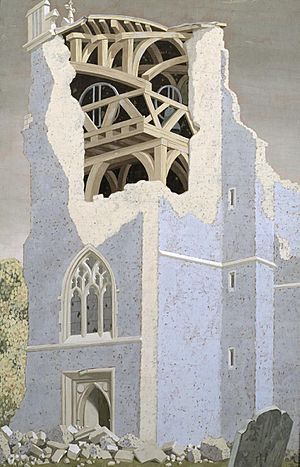
Paycocke's House
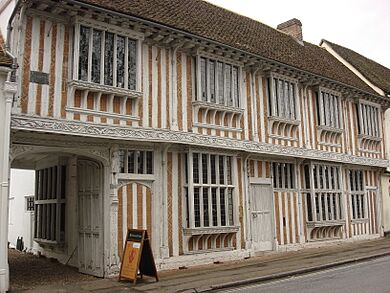
Paycocke's House was built around 1500 by John Paycocke. It's thought to have been a wedding gift for his son Thomas and his wife Margaret, as their initials are carved into the wood. The house has amazing wood panelling and carvings, showing how much money the wool trade brought to this area.
The Paycocke family were successful butchers who started raising their own sheep for wool. They became very wealthy cloth merchants. Thomas was the last Paycocke to live in Coggeshall, dying in 1580. The house was later given to The National Trust in 1924 and is now open to the public.
Grange Barn
Grange Barn was built by the Cistercians (the monks) in the 13th century to serve the Abbey. It's one of the oldest surviving timber-framed buildings in Europe! It was used for farming until 1960, when it was left empty. In 1989, it was given to The National Trust to be preserved. Today, Grange Barn is open to the public and shows a collection of old farm carts and wagons.
Other Landmarks
The Coggeshall clock tower was built in 1887 to celebrate Queen Victoria's special anniversary (her Diamond Jubilee). It used to be a school for poor children and later a tearoom. Now, it's a wine bar.
Nunn's Bridge is a special iron footbridge over the River Blackwater, built in 1892. It was made by a local blacksmith, Henry 'Dick' Nunn, after the old wooden bridge was washed away and no one else would replace it.
Getting Around: Transport
Bus Services
Coggeshall has had bus services for a long time. In 1881, Moore's Bus ran three times a day to Kelvedon station. Today, the Coggeshall Community Bus (COG1) runs on weekdays to Kelvedon station.
Since 2022, the First Essex number 370 bus service connects Coggeshall with Chelmsford and Colchester (going through Braintree). It runs every 30 minutes Monday to Saturday and every two hours on Sunday.
Roads
Coggeshall is on the old Roman road called Stane Street. Today, the A120 road follows this ancient route. Around 1982, a bypass was built around Coggeshall to help traffic flow better.
Fun Facts and Culture
The "Coggeshall Job"
For a long time, people in Essex used the saying "A Coggeshall job" to mean a silly or pointless piece of work. This was because of funny stories about the villagers being a bit silly. For example, they supposedly tried to chain up a wheelbarrow because they thought it had rabies!
Other stories include the town clock striking 11 times at noon, and the villagers riding to another town to collect the "missing stroke." They also supposedly tried to winch a cow onto the church roof to eat grass, or knock down one of two windmills because they thought there wouldn't be enough wind for both!
Local Tales
- Mary Honywood: A story tells of Mary Honywood, who lived nearby. In a time of religious doubt, she threw a wineglass, saying she would be "damned as surely as this is smashed." But the glass bounced and didn't break! She lived to be 93 and had 365 descendants.
- Coggeshall Volunteers: During the Napoleonic Wars, Coggeshall had to form a group of volunteers to help defend the country. This group famously had 20 officers but only 3 regular soldiers! A schoolmaster named Thomas Harris wrote a funny play about it, which made many townspeople upset, causing them to take their children out of his school.
- Mr Nunn's Bridge: Mr Nunn, a local blacksmith, is famous for building the iron bridge over the Blackwater River. He did it himself after the old wooden bridge was washed away and authorities wouldn't replace it.
- Robin's Brook: This small stream is said to be haunted by the ghost of a woodcutter named Robin.
Media and News
Local news and TV shows for Coggeshall come from BBC East and ITV Anglia. You can also listen to local radio stations like BBC Essex and Heart East. The town is served by local newspapers such as the Braintree and Witham Times and the Essex County Standard.
Sports Teams
Coggeshall has its own football club, Coggeshall Town, which was founded in 1878, making it one of the oldest clubs around! They play in the Essex & Suffolk Border League.
The local cricket team, Coggeshall Town CC, is also very old, formed in the 1800s. They play in the Two Counties Cricket Championship.
Famous People from Coggeshall
- John Jegon (born 1550) – became a Bishop.
- John Rogers (born 1630) – moved away and became the President of Harvard University in America.
- John Owen (1646–51) – a vicar in Coggeshall who became a famous theologian and chaplain to Oliver Cromwell.
- Henry Doubleday (1810–1902) – a scientist and gardener.
- John Carter (1815–50) – a silk weaver who became a well-known artist using his mouth after an accident.
- Tony Newton (1937–2012) – a Conservative politician.
- Luke Wright (born 1982) – a poet who grew up in Coggeshall.
Ralph of Coggeshall
Ralph of Coggeshall Lord Ralph was the sixth leader (abbot) of Coggeshall Abbey from 1207 to 1218. He was a very important writer of his time, known for his work called Chronicon Anglicanum ('Chronicle of English Affairs'). We know a lot about the early history of Coggeshall from his writings. He stopped being abbot in 1218 because of poor health and lived quietly in the Abbey until he died in 1228.
The Coggeshall Gang
In the 1840s, a group of criminals caused trouble in Coggeshall and nearby villages. They were known for breaking into homes and robbing people, often targeting older residents. Their main meeting place was the Black Horse Inn.
One member of the group was caught, and the gang leader promised to take care of his family if he didn't tell on his friends. But after the trial, his mother said the gang wasn't helping his family, so he decided to tell the police everything he knew.
The new county police were sent to the Black Horse Inn. Some of the gang were caught there, but the leader made a daring escape over the rooftops. He was eventually arrested trying to get on a ship to France.
Twenty men from the gang were brought to trial. Many people came to watch the trial because there was so much interest in the gang. One member was sentenced to be transported to Australia for life, and others were sent there for shorter periods. Interestingly, some of these men later became successful in Australia, owning farms or businesses and becoming respected members of their new communities.
Learning in Coggeshall: Education
The Cistercian monks at the Abbey had a library and even a school before 1464, which was unusual for their order.
Sir Robert Hitcham's School was started in 1636. It was set up to educate 20 or 30 of the poorest children in the town and help them get apprenticeships (training for a job). This school operated until the mid-20th century.
A national school was started in 1838–39. The British school was built in 1841 to educate poor children.
In the late 20th century, St Peter's School Church of England Primary School opened. It was rebuilt in the 1980s.
In 2008, a Montessori School was founded in rooms above Christ Church.
Coggeshall has one comprehensive secondary school called Honywood Community Science School.
|image_caption The Woolpack Inn.jpg|The Woolpack Inn, Coggeshall, United Kingdom Martyrdom of Thomas Haukes.png|Thomas Hawkes on Market Hill, he is saying "O Lord receive my Spirit" </gallery>
 In Spanish: Coggeshall para niños
In Spanish: Coggeshall para niños


